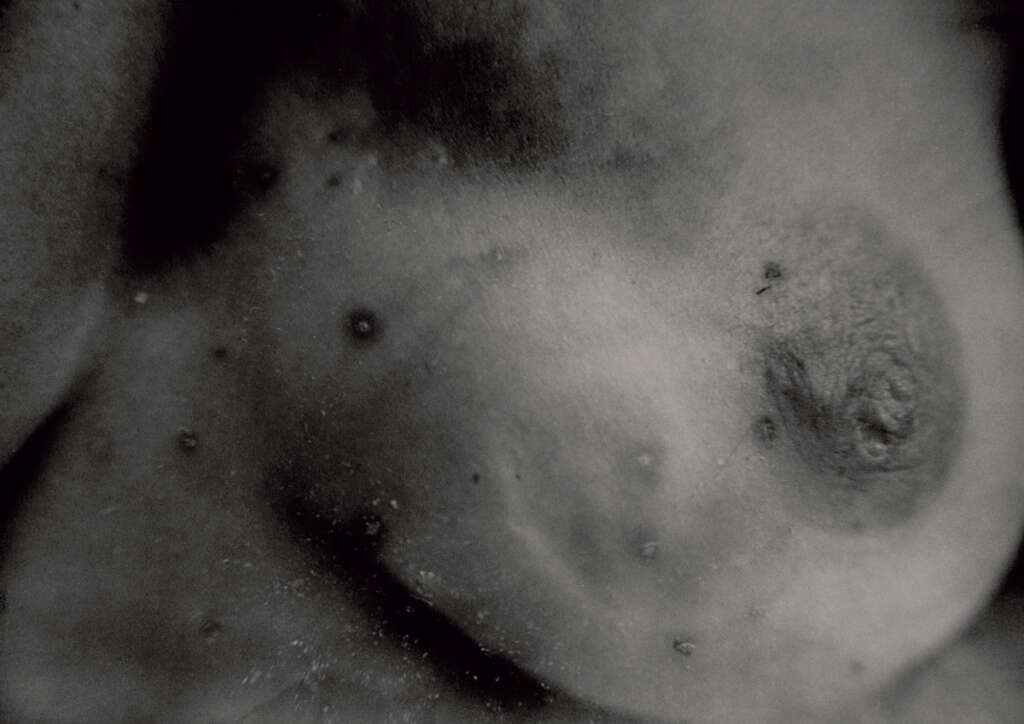Transgression - Magda Hueckel and georgia Krawiec

I am, I exist, I live. Three words, none of which brings us closer to the mystery of our
existence. I and my body, the world and my reality in it. The eternal lessons of darkness*.
The body is the visual evidence of our being, the bridge between the spiritual interior
and the external material world. Exceptionally, it happens to man to establish
The thread of understanding with the individual - other - interior, and it is surprising how many collective
follies, ideologies and utopias have won our trust over the centuries.
Believers and secularists alike, appallingly
Alone we wander through the invisible
scaffolding of the constructed
In the murderous race of nations and generations
The devil's sarcophagus of life. In the world of
modern deaths are not threatened by unemployment,
although its existence and activity
We shamefully hide in it or where
elsewhere. And to the extent that we harness the
its head, it is when it is catastrophic
Or great. In times of triumphant
apologia of youth, worship of the body,
beauty and sexuality - the death that accompanies the
to everyone from birth, has been
hidden in the space of silence
and I guess only art can stand
With her face to face. And if something new
has emerged in this matter is that to
considerations about it more and more frequently and boldly
young women are trying on. Admittedly,
The 21st century was predicted to be an era of women;
nonetheless, it seems surprising
the role reversal by the fair sex
mirror and directing it not towards a narcissistic
vanity, but inevitably
The end of its own existence.
"Obsessive Self-Portraits" by Magda.
Hueckel seem put out, as if
Almost all the light escaped from them, and a boundless, ashen shadow of sadness remained.
And although these are superimpositions of fragments of its
body and decaying plants or
fruit, associations with the fading soul
They are not easily and painlessly chased away.
In some ways, her work is reminiscent of
illustrations of mysterious diseases
From the diary of a retired dermatologist.
In the visual layer, obsessions
seem to focus on the fragility of
coating covering the pulsating sub
her awareness of life and the constant
death process. Young, beautiful
Artist's body covered with ugly stains
and wrinkles of rotting fruit
brings to mind old age, and so at the same time
a certain wisdom. After all, the fruit
hides the seeds and, like a woman
Is a repository for future life.
A vegetable can also mean a person here,
living in the biological sense,
but without being able to contact our
world - vegetating. Grim and true
To the pain at the same time....

georgia Krawiec in her "Exodus "uses a completely different, ironic and derisive tone of a somewhat surreal mourning piece. What primarily unites the two artists is a certain amount of madness and revelation of mortality with all the fears or obsessions that can accompany it. Both also consistently use a dark low key** technique belonging moodily to the genre of nocturnes. The fact that georgia used a pinhole camera in this case is as much a theatricalization of the seriousness of death as it is a suggestion of a return to the origins of existence, both human and image. In its essence, it may even be a kind of performance enslaved by the shell of the revolutionary spirit, or a kind of Book of Unspeakable, Silent Questions....
(This is an excerpt from the text for the catalog
exhibitions by Magda Hueckel and georgia Krawiec
Entitled "Transgression," whose
the vernissage will take place on April 1, 2011
at FF gallery in Lodz)
- Leçons de ténebrès (Lessons of darkness,
darkness) in the Catholic tradition symbolize the
The loneliness of Christ abandoned
By the apostles.
** Low key (low key) in photography technique.
based on the use of predominantly
parts of dark tones.





The article appeared in issue 35 of "Fotografia Quarterly" in 2010
